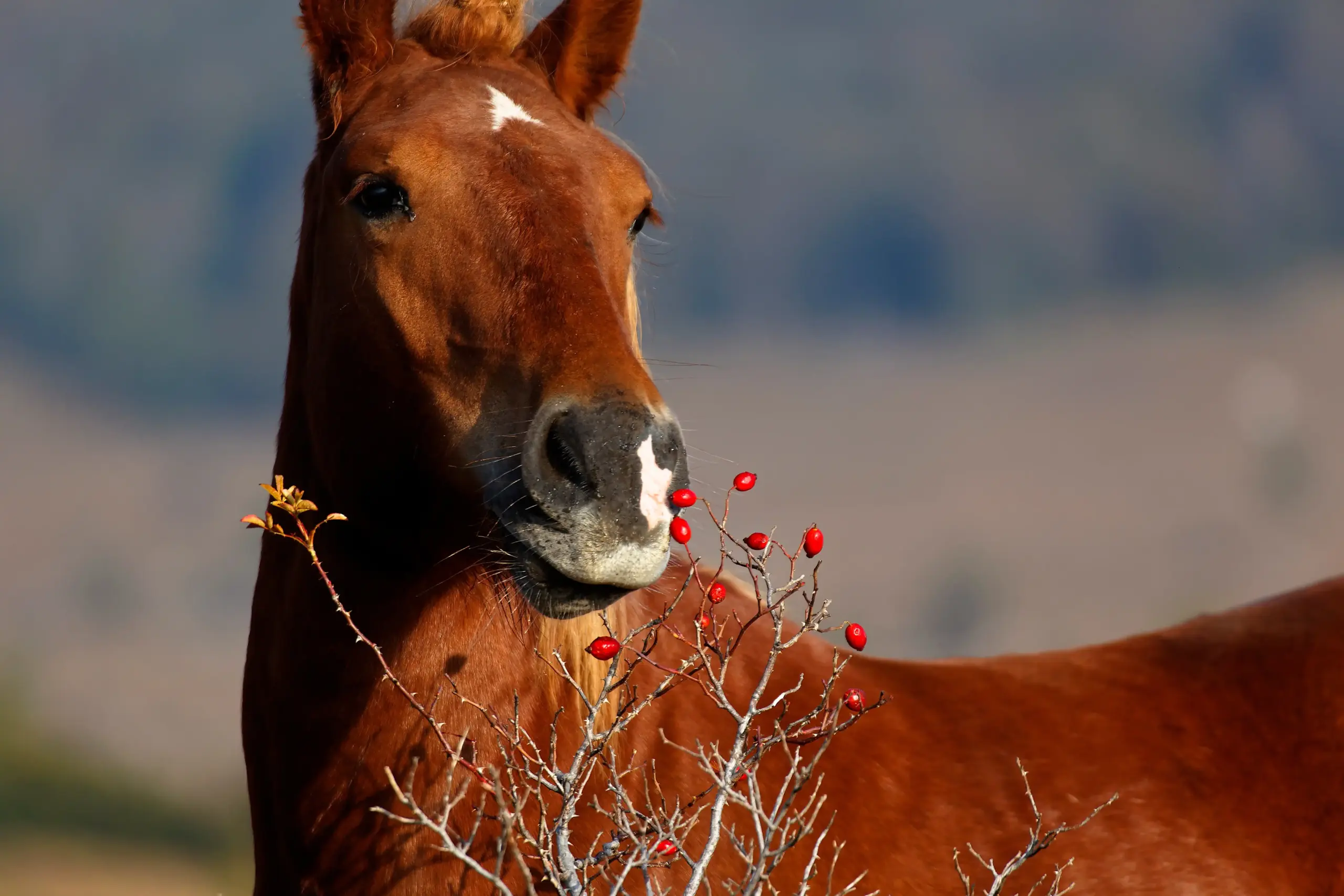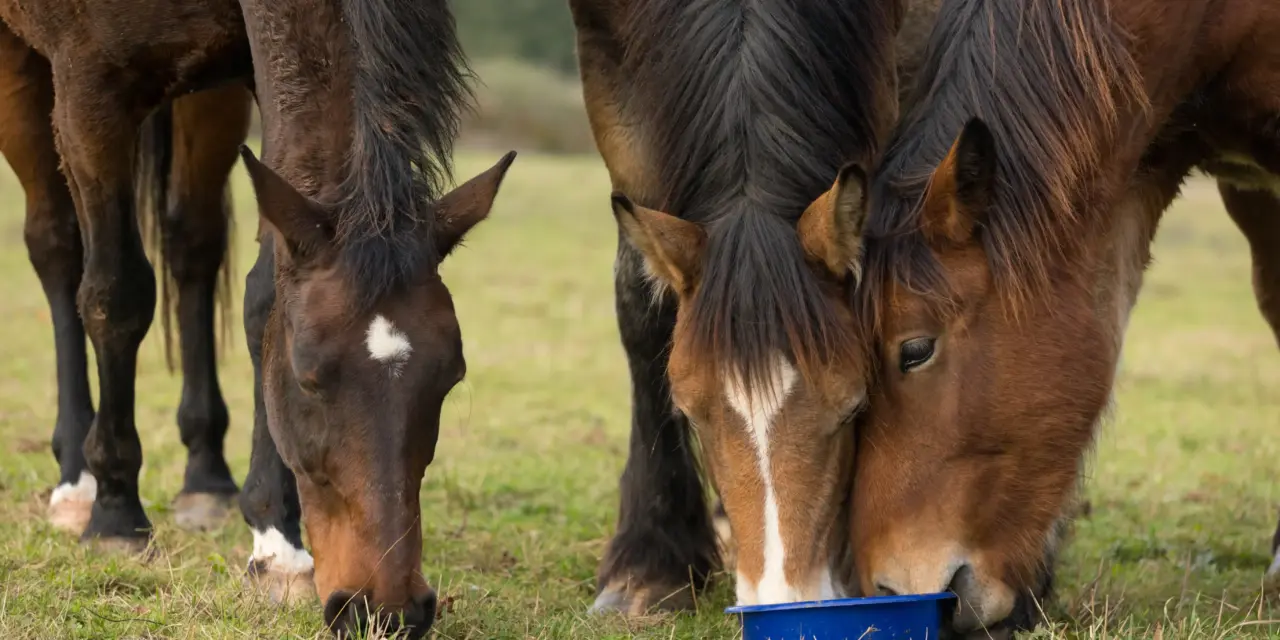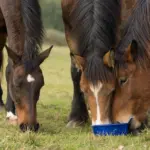Vitamin A plays a crucial role in equine and human health – a fact that was already known in ancient times. Egyptian medical texts from around 1550 B.C. recommended eating liver (the main storage organ for vitamin A) as a treatment for night blindness. Today we know that vitamin A – chemically known as retinol – is essential for maintaining the health of the retina in the eye, and for a wide range of metabolic and developmental processes.
Origin and Intake
Horses primarily obtain vitamin A not in its active form, but as provitamin A – mainly β-carotene, a reddish plant pigment found in green forage like pasture grass, alfalfa, herbs, and leaves, as well as in brightly colored fruits and roots such as carrots or rose hips. In the small intestine, β-carotene is enzymatically cleaved to retinal, which is then converted to retinol. This retinol is stored in the liver in the form of retinyl esters and can be mobilized when needed.
Transport in the blood
Before entering the bloodstream, retinol binds to a transport protein (RBP) and forms a complex with transthyretin (TTR), preventing it from being filtered out by the kidneys. The tightly regulated system ensures that blood plasma levels of retinol remain stable, meaning that a simple blood test cannot reliably indicate a horse’s vitamin A status.
Chemical forms and functions
In the body, vitamin A appears in several chemical forms: it is stored as retinyl esters in the liver, transported as retinol in plasma, and converted to retinal and retinoic acid in target tissues. The isomer 11-cis-retinal is crucial for vision, acting as the light-sensitive chromophore in retinal photoreceptor cells. When light hits it, it isomerizes to all-trans-retinal, triggering a cascade that sends an impulse to the brain via the optic nerve. This process explains why vitamin A deficiency first manifests as poor night vision.
Vitamin A is also vital for epithelial health, reproduction, immune function, and bone metabolism. It regulates the expression of over 500 genes, especially those involved in cell differentiation. In adult horses, a deficiency can lead to dry skin, brittle hooves, compromised mucosal barriers, poor fertility, and increased susceptibility to infections. In broodmares, deficiency may result in placental dysfunction, low birth weight, limb deformities, and developmental delays in foals.
Risks associated with excess levels
On the other hand, excessive vitamin A intake, particularly in growing horses, can cause bone malformations, soft tissue fragility, and even behavioral changes. Toxic effects are likely when horses consume more than five times the recommended daily intake, often due to over-supplementation with fortified feeds or vitamin-rich concentrates.
Bioavailability and levels in feedstuffs
The bioavailability of Vitamin A depends on several factors, including liver vitamin stores, age, and the physiological state of the horse. Typically, only about 1/40 of ingested β-carotene is converted into vitamin A, a mechanism that prevents hypervitaminosis A under natural feeding conditions. Fresh pasture contains around 50–75 mg of β-carotene per kg of dry matter, which translates to 20,000–30,000 IU of vitamin A per kg of ingested dry matter. In contrast, hay contains significantly less – around 10,000–16,000 IU/kg when freshly harvested and sun-dried. After 6 months of storage, vitamin A content in hay is nearly depleted unless it remains visibly green.
Storage capacity and deficiency symptoms
Thanks to its storage capacity in the liver, a horse can tolerate short-term periods without vitamin A intake. However, horses on long-term hay-only diets without access to fresh forage or supplemental β-carotene may deplete their liver stores within 1–2 months. In such cases, small amounts of carrots or rose hips can help bridge the gap – two to three carrots daily typically suffice in winter.

Modern feeding practices
In general, vitamin A deficiency is rare in modern horse management, provided horses receive decent-quality hay, seasonal pasture, and occasional carotene-rich feeds like a carrot or a handful of rose hips. Over-supplementation, especially in young horses, is a more common problem due to highly fortified concentrates or vitaminized mineral mixes. The effects of synthetic β-carotene and vitamin A supplements are still being studied; their stability and absorption vary depending on processing, storage, and the specific formulation.
Nutritional needs based on the roles or requirements horses fulfil
A common concern among horse owners is whether the ration provides enough vitamin A for breeding mares or growing young horses. The maintenance requirement for vitamin A in adult horses (both leisure and sport horses) is around 1,600 IU per day. In broodmares during the last 90 days of pregnancy as well as in breeding stallions, this increases to around 3,500 IU per day. Lactating mares still have a significantly increased need and require about 3,000 IU per day, as do foals. The requirement gradually decreases with age: a yearling still needs about 2,500 IU per day until it reaches the standard maintenance level of 1,600 IU per day at age 3.
Sample calculation for feeding requirements
Let’s take a closer look at a typical mineral feed like OKAPI Junior Mineral (Performance Mineral) that contains 100,000 IU of vitamin A per kilogram. If the recommended daily amount is 100 grams, this provides:
100,000 IU ÷ 10 = 10,000 IU of vitamin A per day.
Now let’s compare this with the actual daily requirements:
- An adult horse needs around 1,600 IU/day
- A pregnant mare (last trimester) or a stallion needs about 3,500 IU/day
- EA lactating mare and a foal both need approximately 3,000 IU/day
- A yearling requires about 2,500 IU/day. So with just 100 g of this mineral feed, even a lactating mare or a growing foal is receiving more than three times their daily requirement, and adult horses or yearlings are even more comfortably covered.
Nutritional supply: key takeaways
In other words: Yes – a properly dosed mineral feed like this is more than sufficient to meet the vitamin A needs of any healthy horse, including broodmares and youngsters, even if synthetic vitamin A is not absorbed to a 100% in the intestines.
It’s also important to keep in mind that forage like hay or alfalfa still contributes to the horse’s vitamin A intake, even though the exact amount is hard to measure – especially when forage batches change often. While vitamin A levels in hay decline over time, sun-cured hay or forage stored under good conditions still contains usable amounts, especially if it retains a greenish color.
As a result, most horses in balanced feeding programs are already well supplied with vitamin A – and the bigger risk in modern feeding practices is often over-supplementation, not deficiency.
- Vitamin A in Horses – Origin, Metabolism, Function, and Requirements - 15. May 2025
- Linseed in Horse Feeding - 28. January 2025
- What is Adiponectin And How Can We Use It? - 21. October 2024










